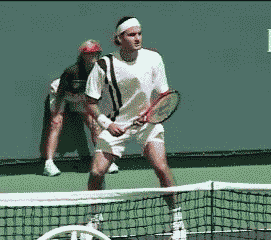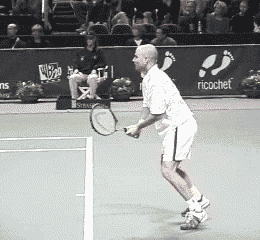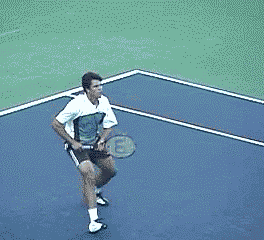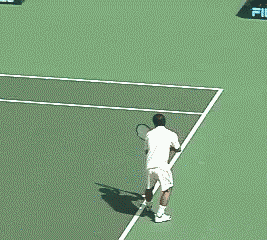|
TennisOne Lessons Ignore These Five Common Phrases and Improve Your Game! In over 20 years of teaching tennis I have never said any of the following to my students:
These types of phrases create more problems and confusion for tennis players than they do help. Why? Lets examine them individually and I will share some alternative approaches used by our tennis professionals in Peter Burwash International. Watch the Ball I have never tossed or hit a ball to a student's forehand and had them take a backhand swing! Everyone watches the ball naturally. They make mistakes because of what happens at contact between the racquet and ball, not because they don't watch the ball. Numerous studies have been done on how baseball players "lose" the ball when it is about 3-5 feet from them in the batters box. The same thing happens for tennis players! It is impossible to literally watch the ball hit your strings unless you hold the racquet head in front of your face at the time of contact! Alternative Approach: We always encourage our students to develop "Triple Vision" whereby they are aware of the ball, court, and opponent simultaneously. Think of a wide receiver in football making a catch near the sideline. They are aware of the ball, sideline boundary, and the defender. You already use this concept but may not be aware of it!? How? When you are at the baseline and your opponent is coming to the net, you "see the whole picture" of the ball, court, and opponent. Take Your Racquet Back The problem with this phrase is there are numerous times when you don't take your racquet back! Returning a fast serve or shot to your forehand or backhand groundstroke; a volley, a ball hit right at you, a half-volley, when you are having a slow day either mentally or physically or both. When I ask my students to show me what "take your racquet back" means to them, almost all of them swing so the tip of the racquet of the head is pointing towards the fence behind them. Yet, if I feed or hit them a fast ball, they are never able to get the racquet head back to that position in order to have time to hit the shot. So, after a few fast balls they "automatically" adjust their backswing to compensate.
Alternative Approach: PBI Professionals have our students think of "racquet preparation" as this allows them to adjust their backswing depending on the situation. On one shot you may have a six inch racquet preparation and the next shot the preparation may be two feet and both of them are "right." Prepare your racquet depending on the ball speed and situation you are in. Bend Your Knees How many people have you seen play tennis for an entire match with their knees in a locked position so they move stiff-legged all over the court?! Would you bend your knees on a ball which is bouncing over your head? When I toss or hit a low ball to my students they almost always bend their knees without my telling them to do so. It is a natural reaction. Like these other phrases, "bend your knees" takes up unnecessary "mental space" in your mind and doesn't apply in many situations. If you are at the net and a lob goes over your head; when running back to hit the shot are you going to think about bending your knees? Alternative Approach: Don't even worry about bending your knees! Unless you have chronic back and/or leg problems, which would make the phrase "bend your knees" useless anyway. You will naturally bend your knees when it is necessary to do so. It is not somethng you have to think about! Punch Your Volleys More than anything else, this is one of the most dangerous phrases you can apply to your tennis game!? Think of a punching motion...Bent to straight...Then add the shock of when the ball meets the strings and you have a recipe for arm problems! You could literally be hitting the volley, at the moment of contact, with a locked elbow. Ouch!
In addition, the phrase becomes impractical very quickly when trying to expand your variety of volley shots! How do you hit a drop volley or soft angled volley with a punching motion? How do you get the ball over the net when you use a punching action on a low volley? Will you punch the volley when the ball is hit right at you? Whenever you play against someone who has a punch volley, hit them low balls and they will punch almost every one of them into the net! Alternative Approach: PBI Professionals when teaching the volley will often ask a student to "catch the ball" when we toss it to them. Never does anyone use a punching motion to make the catch! They simply hold out their hand and catch the ball with a BENT arm! Therefore, rather than using a bent to straight punching motion, think "catch" with your motion being bent to bent. It is a two ounce ball and you are at the net. You don't have to swing or punch for the ball to go over! The Ball Toss Is the Most Important Part of the Serve I grew up in the Pacific Northwest. To play year-round required playing indoors. Every tennis club had different lighting. Then the warm weather would come and we would move outdoors only to have to deal with sun and wind. Every time I thought I had mastered "the perfect toss" either lights, sun, wind, or combination thereof would force me to change my toss! Think about it. If the toss is the most important part of the serve then when you toss the ball something would happen!? The subsequent swing and contact are more important than the toss. Watch the pros and you will see a variety of ball tosses both in terms of placement and height.
Alternative Approach: Your toss is going to vary due to lighting, sun, wind, fatigue, and match pressure. Accept it! PBI Professionals prefer to emphasize having a relaxed hitting hand/wrist. If you grip a ball as tight as you can and then try to throw it like a baseball pitching motion, how effective will it be? You can serve or throw a ball faster, with more accuracy, and greater variety with a relaxed hitting hand and wrist! Rather than worry so much about your toss, simply make adjustments to less than desirable ball tosses with a relaxed hitting hand and wrist. Conclusion In a competitive situation, the goal of your opponent is to make your life miserable! If you play someone who allows you to stand in one place and comfortably hit the ball, then you are playing someone who is not challenging you! The fact is, in a competitive match you will be on the run or moving most of the time. If there was one "right way" to play tennis then, when you watch the pros, they would all look the same! Ignore the common phrases noted above and you will be able to more quickly develop a style of play which works best for you!
Dave Kensler has been teaching tennis for 23 years with Peter Burwash International(PBI). PBI contracts with resorts, hotels and clubs all over the world to direct tennis programs. The company presently has professionals working at 62 facilities in North America, Europe, Asia, Middle East, Caribbean, Pacific and Indian Ocean. During its 30 years in business, PBI tennis professionals have taught tennis in over 135 countries. For more information visit: www.pbitennis.com. |




